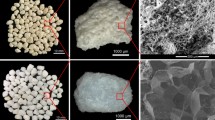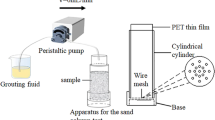Abstract
To explore the optimized design of bio-mediated soil enhancement, the influence of different calcium sources (i.e., calcium acetate, calcium nitrate, and calcium chloride) and magnesium ion concentrations (to simulate the seawater environment) on calcareous sand treated with microbially induced carbonate precipitation (MICP) technique was investigated. Unconfined compression tests and carbonate content tests were conducted to characterize the mechanical strength and carbonate amounts, respectively. The changes of calcium ion concentration and electrical conductivity of the MICP solution were monitored in the bio-mineralization process. Scanning electron microscopy (SEM) observation reveals the carbonate crystal morphologies and X-ray diffraction (XRD) analysis quantifies the mineral compositions of carbonate precipitations. The experimental results show that the bio-cemented samples treated with calcium acetate achieve higher carbonate content, while those treated with calcium nitrate or calcium chloride give higher strength. The addition of 0.05 M magnesium ions (i.e., close to the magnesium ion concentration in seawater) enhances the mechanical strength of the bio-cemented samples treated with each calcium source. When magnesium ion concentration increased to 0.5 M, the bio-cemented samples treated with calcium chloride achieve the highest strength and the highest carbonate content. Moreover, calcium source type affects the MICP reaction rate and additional magnesium ion could slow down the reaction rate of calcium ions. SEM and XRD analysis results highlight the strong dependence of the morphological features and mineral compositions of carbonate precipitations on calcium source and magnesium ion concentration.












Similar content being viewed by others
Data availability
All data used during the study appear in the submitted article.
References
Achal V, Pan XL (2014) Influence of calcium sources on microbially induced calcium carbonate precipitation by Bacillus sp. CR2. Appl Biochem Biotechnol 173(1):307–317
Akoğuz H, Çelik S, Barış Ö (2019) The Effects of Different Sources of Calcium in Improvement of Soils by Microbially Induced Calcite Precipitation (MICP). Sigma J Eng Natl Sci 37(3):953–965
Al Qabany A, Soga K (2014) Effect of chemical treatment used in MICP on engineering properties of cemented soils. In: Bio-and Chemo-Mechanical Processes in Geotechnical Engineering: Géotechnique Symposium in Print 2013. ICE Publishing. pp. 107–115.
Anbu P, Kang CH, Shin YJ, So JS (2016) Formations of calcium carbonate minerals by bacteria and its multiple applications. Springerplus 5(1):1–26
Astilleros J, Fernández-Díaz L, Putnis A (2010) The role of magnesium in the growth of calcite: an AFM study. Chem Geol 271(1–2):52–58
ASTM (2000) D2166: Standard Test Method for Unconfined Compressive Strength of Cohesive Soil. ASTM International: West Conshohocken, PA, USA
ASTM (2011) D2487: Standard practice for classification of soils for engineering purposes. ASTM International: West Conshohocken, PA, USA
Brennan ST, Lowenstein TK (2002) The major-ion composition of Silurian seawater. Geochim Cosmochim Acta 66(15):2683–2700
Cheng L, Cord-Ruwisch R, Shahin MA (2013) Cementation of sand soil by microbially induced calcite precipitation at various degrees of saturation. Can Geotech J 50(1):81–90
Cheng L, Shahin MA, Cord-Ruwisch R (2014) Bio-cementation of sandy soil using microbially induced carbonate precipitation for marine environments. Géotechnique 64(12):1010–1013
Cheng L, Shahin MA, Mujah D (2017) Influence of key environmental conditions on microbially induced cementation for soil stabilization. J Geotech Geoenviron Eng 143(1):04016083
Cheng YJ, Tang CS, Pan XH, Liu B, Xie YH, Cheng Q, Shi B (2021) Application of microbial induced carbonate precipitation for loess surface erosion control. Eng Geol 294:106387
Chu J, Ivanov V, Naeimi M, Stabnikov V, Liu HL (2014) Optimization of calcium-based bioclogging and biocementation of sand. Acta Geotech 9(2):277–285
Chung FH (1974) Quantitative interpretation of X-ray diffraction patterns of mixtures II Adiabatic principle of X-ray diffraction analysis of mixtures. J Appl Crystallogr 7(6):526–531
Cui MJ, Zheng JJ, Dahal BK, Lai HJ, Huang ZF, Wu CC (2021) Effect of waste rubber particles on the shear behaviour of bio-cemented calcareous sand. Acta Geotech 16(5):1429–1439
Davis KJ, Dove PM, Wasylenki LE, De Yoreo JJ (2004) Morphological consequences of differential Mg2+ incorporation at structurally distinct steps on calcite. Am Mineral 89(5–6):714–720
De Leeuw NH, Parker SC (1998) Surface structure and morphology of calcium carbonate polymorphs calcite, aragonite, and vaterite: an atomistic approach. J Phys Chem B 102(16):2914–2922
DeJong JT, Mortensen BM, Martinez BC, Nelson DC (2010) Bio-mediated soil improvement. Ecol Eng 36(2):197–210
Dhami NK, Mukherjee A, Watkin EL (2018) Microbial diversity and mineralogical-mechanical properties of calcitic cave speleothems in natural and in vitro biomineralization conditions. Front Microbiol 9:40
El Mountassir G, Minto JM, van Paassen LA, Salifu E, Lunn RJ (2018) Applications of microbial processes in geotechnical engineering. Adv Appl Microbiol 104:39–91
Fang XW, Yang Y, Chen Z, Liu HL, Xiao Y, Shen CN (2020) Influence of fiber content and length on engineering properties of MICP-treated coral sand. Geomicrobiol J 37(6):582–594
Fukue M, Ono S-I, Sato Y (2011) Cementation of sands due to microbiologically-induced carbonate precipitation. Soils Found 51(1):83–93
Gawwad HA, Mohamed SAE-A, Mohammed SA (2016) Impact of magnesium chloride on the mechanical properties of innovative bio-mortar. Mater Lett 178:39–43
Hu FH, Fang XW, Yao ZH, Wu HR, Shen CN, Zhang YT (2021) Experiment and discrete element modeling of particle breakage in coral sand under triaxial compression conditions. Mar Georesour Geotechnol 23:1–10
Imran MA, Nakashima K, Kawasaki S (2021) Bio-mediated soil improvement using plant derived enzyme in addition to magnesium ion. Crystals 11(5):516
Ismail MA, Joer HA, Sim WH, Randolph MF (2002) Effect of cement type on shear behavior of cemented calcareous soil. J Geotech Geoenviron Eng 128(6):520–529
Ivanov V, Chu J (2008) Applications of microorganisms to geotechnical engineering for bioclogging and biocementation of soil in situ. Rev Environ Sci Bio/Technol 7(2):139–153
Jagner D (1974) High-precision determination of calcium in the presence of higher concentrations of magnesium by means of a computerized photometric titration: application to sea water. Anal Chim Acta 68(1):83–92
Jiang NJ, Soga K (2017) The applicability of microbially induced calcite precipitation (MICP) for internal erosion control in gravel-sand mixtures. Géotechnique 67(1):42–55
Jiang NJ, Tang CS, Hata T, Courcelles B, Dawoud O, Singh DN (2020) Bio-mediated soil improvement: the way forward. Soil Use Manage 36(2):185–188
Kumar JS, Nusari MS, Purushotam D, Prasad AI, Rajyaswori S (2021) Effectiveness of geocell wall, geogrid and micropile anchors for mitigation of unstable slopes. Geoenvironmental Disasters 8(1):1–15
Li YJ, Guo Z, Wang LZ, Ye Z, Shen CF, Zhou WJ (2021) Interface shear behavior between MICP-treated calcareous sand and steel. J Mater Civ Eng 33(2):04020455
Liu B, Zhu C, Tang CS, Xie YH, Yin LY, Cheng Q, Shi B (2020) Bio-remediation of desiccation cracking in clayey soils through microbially induced calcite precipitation (MICP). Eng Geol 264:105389
Liu B, Tang CS, Pan XH, Zhu C, Cheng YJ, Xu JJ, Shi B (2021) Potential drought mitigation through microbial induced calcite precipitation-MICP. Water Resour Res 57(9):e20
Liu L, Liu HL, Stuedlein AW, Evans TM, Xiao Y (2019) Strength, stiffness, and microstructure characteristics of biocemented calcareous sand. Can Geotech J 56(10):1502–1513
Loste E, Wilson RM, Seshadri R, Meldrum FC (2003) The role of magnesium in stabilising amorphous calcium carbonate and controlling calcite morphologies. J Cryst Growth 254(1–2):206–218
Lv C, Zhu C, Tang CS, Cheng Q, Yin LY, Shi B (2021) Effect of fiber reinforcement on the mechanical behavior of bio-cemented sand. Geosynth Int 28(2):195–205
Lv C, Tang CS, Zhu C, Li WQ, Chen TY, Zhao L, Pan XH (2022) Environmental Dependence of Microbially Induced Calcium Carbonate Crystal Precipitations: Experimental Evidence and Insights. J Geotech Geoenviron Eng 148(7):04022050
McDowell GR, Bolton MD (1998) On the micromechanics of crushable aggregates. Géotechnique 48(5):667–679
Peng J, Cao TC, He J, Dai D, Tian YM (2022) Improvement of coral sand with MICP using various calcium sources in sea water environment. Front Phys 10:82
Putra H, Yasuhara H, Kinoshita N, Neupane D, Lu CW (2016) Effect of magnesium as substitute material in enzyme-mediated calcite precipitation for soil-improvement technique. Front Bioeng Biotechnol 4:37
Rahman MM, Hossain MA, Ali MR, Ahmed Z, Hedayutul Islam AHM (2022) Assessing vulnerability and adaptation strategy of the cyclone affected coastal area of Bangladesh. Geoenvironmental Disasters 9(1):1–20
Sudha Rani NNV, Satyanarayana ANV, Bhaskaran PK (2015) Coastal vulnerability assessment studies over India: a review. Nat Hazard 77(1):405–428
Sun XH, Miao LC, Wu LY, Wang CC (2019) Study of magnesium precipitation based on biocementation. Mar Georesour Geotechnol 37(10):1257–1266
Tang CS, Yin LY, Jiang N-j, Zhu C, Zeng H, Li H, Shi B (2020) Factors affecting the performance of microbial-induced carbonate precipitation (MICP) treated soil: a review. Environ Earth Sci 79(5):1–23
Tang CS, Li H, Pan XH, Yin LY, Cheng L, Cheng Q, Liu B, Shi B (2022) Coupling effect of biocementation-fiber reinforcement on mechanical behavior of calcareous sand for ocean engineering. Bull Eng Geol Environ 81(4):1–15
Van Paassen LA, Ghose R, Van der Linden TJM, Van der Star WRL, Van Loosdrecht MCM (2010) Quantifying biomediated ground improvement by ureolysis: large-scale biogrout experiment. J Geotech Geoenviron Eng 136(12):1721–1728
Wang DL, Tang CS, Pan XH, Wang R, Li JW, Dong ZH, Shi B (2022) Construction and demolition waste stabilization through a bio-carbonation of reactive magnesia cement for underwater engineering. Constr Build Mater 335:127458
Wang XZ, Jiao YY, Wang R, Hu MJ, Meng QS, Tan FY (2011) Engineering characteristics of the calcareous sand in Nansha Islands. South China Sea Eng Geol 120(1–4):40–47
Wang YZ, Soga K, DeJong JT, Kabla AJ (2019) Microscale visualization of microbial-induced calcium carbonate precipitation processes. J Geotech Geoenviron Eng 145(9):04019045
Wei LX, Liu JQ, Wu XL, Liu XY, Lv XW, Liu YL (2020) In situ fabrication of Ti–Al/Ti2AlC composite by hot-press sintering. J Alloys Compd 813:152200
Whiffin VS, Van Paassen LA, Harkes MP (2007) Microbial carbonate precipitation as a soil improvement technique. Geomicrobiol J 24(5):417–423
Wu Y, Li N, Wang XZ, Cui J, Chen YL, Wu YH, Yamamoto H (2021) Experimental investigation on mechanical behavior and particle crushing of calcareous sand retrieved from South China Sea. Eng Geol 280:105932
Xiao P, Liu HL, Xiao Y, Stuedlein AW, Evans TM (2018) Liquefaction resistance of bio-cemented calcareous sand. Soil Dyn Earthquake Eng 107:9–19
Xiao P, Liu HL, Stuedlein AW, Evans TM, Xiao Y (2019) Effect of relative density and biocementation on cyclic response of calcareous sand. Can Geotech J 56(12):1849–1862
Xiao Y, Zhang ZC, Stuedlein AW, Evans TM (2021) Liquefaction modeling for biocemented calcareous sand. J Geotech Geoenviron Eng 147(12):04021149
Xu XC, Guo HX, Cheng XH, Li M (2020) The promotion of magnesium ions on aragonite precipitation in MICP process. Constr Build Mater 263:120057
Zeng H, Yin LY, Tang CS, Zhu C, Cheng Q, Li H, Lv C, Shi B (2021) Tensile behavior of bio-cemented, fiber-reinforced calcareous sand from coastal zone. Eng Geol 294:106390
Zhang ML, Zhao L, Li GK, Zhu C, Dong SJ, Li ZB, Tang CS, Ji JF, Chen J (2021) Microbially induced magnesium carbonate precipitation and its potential application in combating desertification. Geomicrobiol J 38(6):549–560
Zhang Y, Guo HX, Cheng XH (2015) Role of calcium sources in the strength and microstructure of microbial mortar. Constr Build Mater 77:160–167
Acknowledgements
This work was supported by the National Natural Science Foundation of China (Grant No. 42230710, 41925012, 42007244, 41902271), Natural Science Foundation of Jiangsu Province (Grant No. BK20211087).
Author information
Authors and Affiliations
Corresponding author
Additional information
Publisher's Note
Springer Nature remains neutral with regard to jurisdictional claims in published maps and institutional affiliations.
Rights and permissions
Springer Nature or its licensor (e.g. a society or other partner) holds exclusive rights to this article under a publishing agreement with the author(s) or other rightsholder(s); author self-archiving of the accepted manuscript version of this article is solely governed by the terms of such publishing agreement and applicable law.
About this article
Cite this article
Lv, C., Tang, CS., Zhang, JZ. et al. Effects of calcium sources and magnesium ions on the mechanical behavior of MICP-treated calcareous sand: experimental evidence and precipitated crystal insights. Acta Geotech. 18, 2703–2717 (2023). https://doi.org/10.1007/s11440-022-01748-6
Received:
Accepted:
Published:
Issue Date:
DOI: https://doi.org/10.1007/s11440-022-01748-6




